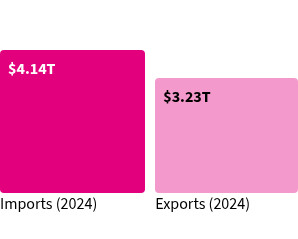How much food does the US export?
Grains and soybeans are the top US agricultural exports, and Mexico and Canada are the top food export markets.
In 2024, the US exported nearly $176 billion in agricultural products — that’s 10.2% of all the goods exported that year. The Department of Agriculture (USDA) defines “agricultural products” to include commodity crops like corn and wheat; livestock, poultry, and byproducts like eggs and dairy; and a range of other goods: fruits, vegetables, coffee, seafood, oilseeds, and alcoholic beverages. It also includes processed foods like baked goods, fruit and vegetable products, condiments, and sauces.
On average, the US exports about 20% of its US agricultural production every year.
Food exports have increased 66% since 2003.
US domestic agricultural exports to the world, 2003–2024. Adjusted to 2024 dollars.
Exports have been increasing, in part, as US agricultural production outpaces domestic demand, leaving producers with surpluses that are sold internationally.
Adjusting for inflation, the value of US agricultural exports has risen 72.8% since 2000. Exports peaked in 2022 at $209.7 billion. They also surpassed $200 billion in 2014 and 2021, reaching $204 billion in both years.
Food exports have generally made up around 10% of US domestic good exports each year since 2005, with some year-to-year variation. Since 2008 they’ve consistently exceeded 10%, peaking at 12.4% in 2020.
What is the US’s biggest agricultural export?
The US’s biggest food export is soybeans: they were 14.0% of all agricultural exports in 2024, with a market value of $24.6 billion. Around half of American soybeans ($12.85 billion worth) are exported to China. The next three biggest markets were the European Union, Mexico, and Indonesia.
Corn was the second-largest export, accounting for 7.9% of US agricultural exports and valued at $13.92 billion. Its biggest buyers were Mexico, Japan, and Colombia.
Beef and beef products (like jerky, canned beef, and beef broth) were the US’s third-largest food export at 5.9% of agricultural exports and $10.45 billion in value. Their largest export markets were South Korea, Japan, and China.

What is each state’s top agricultural export?
States have different top exports:
- Grains and soybeans led in 12 states: Arkansas, Illinois, Louisiana, Maryland, Minnesota, Missouri, Montana, North Dakota, Ohio, Oregon, Virginia, and Washington.
- Meat, 9 states plus Washington, DC: Alabama, Colorado, Georgia, Iowa, Kansas, Nebraska, North Carolina, Oklahoma, and West Virginia.
- Beverages, 5 states: Connecticut, Hawaii, Kentucky, Maine, and Nevada.
- Dairy products, 4 states: Florida, Idaho, New Mexico, and Wisconsin.
- Fruits and vegetables, 4 states: Arizona, Delaware, and Massachusetts.
In the seventeen remaining states, the top agricultural export was in something other than those categories. California’s was tree nuts. Texas’ was ethanol (a corn byproduct). Mississippi’s and Tennessee’s was cotton, and South Carolina’s was cat and dog food.
Who's buying US food exports?
In 2024, Mexico was the largest market for US agricultural exports, buying $30.32 billion in corn, pork and pork products, dairy products, soybeans, and more.
Canada was the second-largest market, buying baked goods, along with fresh fruit and vegetables.
China ranked third, importing $24.65 billion. Its leading purchases were soybeans, beef and beef products, and cotton.
Learn about the role of farm subsidies in US agricultural products, who the US trades with, and get the data straight to your inbox by signing up for our weekly newsletter.
